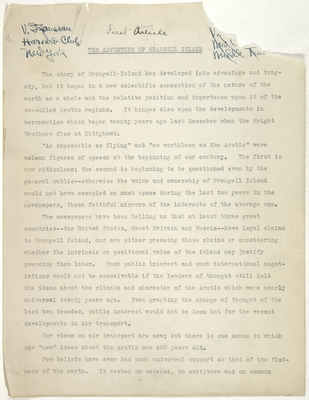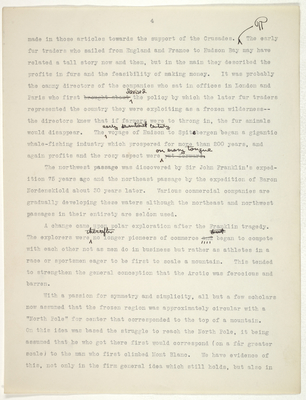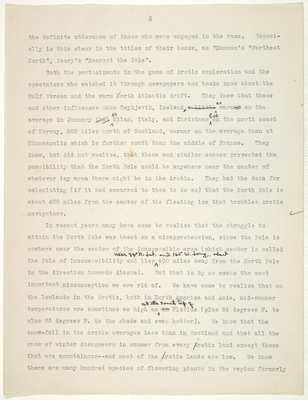Pages
stefansson-wrangel-09-25-003-001
V. Stefansson Harvard Club New York
First Article
THE ADVENTURE OF WRANGELL ISLAND
The story of Wrangell Island has developed into adventure and tragedy, but it began in a new scientific conception of the nature of the earth as a whole and the relative position and importance upon it of the so-called Arctic regions. It hinges also upon the developments in aeronautics which began twenty years ago last December when the Wright Brothers flew at Kittyhawk.
"As impossible as flying" and "as worthless as the Arctic" were solemn figures of speech at the beginning of our century. The first is now ridiculous; the second is beginning to be questioned even by the general public--otherwise the value and ownership of Wrangell Island would not have occupied so much space during the last two years in the newspapers, those faithful mirrors of the interests of the average man.
The newspapers have been telling us that at least three great countries--the United States, Great Britain and Russia--have legal claims to Wrangell Island, and are either pressing those claims or considering whether the intrinsic or positional value of the island may justify pressing them later. Such public interest and such international negotiations would not be conceivable if the leaders of thought still held the ideas about the climate and character of the Arctic which were nearly universal twenty years ago. Even granting the change of thought of the last two decades, public interest would not be keen but for the recent developments in air transport.
Our views on air transport are new; but there is one sense in which our "new" ideas about the Arctic are 400 years old.
Few beliefs have ever had such universal support as that of the flatness of the earth. It rested on science, on scripture and on common
stefansson-wrangel-09-25-003-002
2
observation. No gibe that is now directed against those who believe the Arctic to be inhabitable and fairly pleasant is quite so amusing as those directed four hundred years ago at the advocates of the roundness of the earth, pointing out that in such a case the water would be spilled out of the wells in China and the Chinamen themselves would be walking like flies on a ceiling with feet upwards and pigtails hanging down.
But the nearly universal view of the earth's flatness received such a blow from through the voyages of Columbus and Magellan that it was only another 200 years or so until the majority of Europeans ceased laughing about the inverted Chinamen and began to incline to the view that the earth was probably round.
If the masses were slow-minded, the reverse was true of the leaders, who quickly realized that if the earth were round it would be possible to reach Cathay by sailing west. They tried it but the Americas barred the way and the route to China around the Horn was both long and stormy.
For men in whose lifetime the world had changed from a pancake to a sphere, it was easy to throw by the board all the other geographical conceptions of the ancients. They forgot or disregarded the Greek and Roman doctrine that human and animal life was not possible in the remote north and boldly reasoned that since the earth was a sphere you could reach China not only by sailing west by but also by sailing north. This led to a series of voyages perhaps the most gallant in recorded history. They were productive in terms of knowledge, but negative with regard to the main objective of finding a shortcut to the riches of the East.
When ice barred the way to ships steering directly north, the navigators felt their way east or west along the margin, hoping for a thoroughfare. Long after they had concluded that a direct northerly route was impossible, they cherished the hope of circumventing either North America or Asia by what were known as the Northwest and Northeast passages. Many countries gave to that search a list of dauntless
stefansson-wrangel-09-25-003-003
3
names, but Great Britain was honored beyond them all in Hudson, Davis, Cook, Peary Parry and many others. The search continued hopeful, and for three centuries the Arctic was in men's minds a potential highway to the East. But 75 years ago that period of thought came to a full stop with the colossal tragedy of Sir John Franklin. Begin CopyingNo expedition ever sailed with higher hopes or equipment more sumptuously and carefully provided. Yet no one ever returned from the voyage and the story is known only from the tiniest fragments of documents and from the scattered bones of a few of those who died.
The white and fearful wilderness which the Greeks had assigned to the northern portion of their flat world had been banished from men's minds for three centuries in favor ofby a potentially navigable ocean joining Europe to the coveted East. But the Franklin tragedy gave the lifeless northern wastes of the ancients their second innings. The world was still round, but at the "top" of it men now pictured to themselves an impassably frozen and desert ocean which no longer connected but instead separated Europe and from China.
Commercial endeavors have their roots in a firm optimism. Men hope for success, they hope for profit, and that general frame of mind colors everything they see. The old Norse sagas tell that the discoverers of Greenland in 987 named the country so "thinking that colonists would all the more desire to go there if the land had a fair name”. When Eric the Red went among his Scandinavian countrymen in search of colonists he certainly told them no tales of hardship and terror for he induced twenty-five ships to follow him towards Greenland in 990, each loaded with men, women, children, dogs, cattle, horses, sheep, poultry, and household goods. They built up on the west coast of Greenland what we would now call a "dairy industry". Vatican documents show that the Popes of the middle ages knew that Greenland exported butter, cheese and wool to Europe, and that they the dignitaries of the church were thankful for the contributions which the Greenlanders
stefansson-wrangel-09-25-003-004
4
made in those articles towards the support of the Crusades. The early fur traders who sailed from England and France to Hudson Bay may have related a tall story now and then, but in the main they described the profits in furs and the feasibility of making money. It was probably the canny directors of the companies who sat in offices in London and Paris who first brought about devised the policy by which the later fur traders represented the country they were exploiting as a frozen wilderness-- the directors knew that if farmers were to throng in, the fur animals would disappear. The early seventeeth century voyage of Hudson to Spitsbergen began a gigantic whale-fishing industry which prospered for more than 200 years, and again profits and the rosy aspect were put forwardon every tounge
The northwest passage was discovered by Sir John Franklin’s expedition 75 years ago and the northeast passage by the expedition of Baron Nordenskiold about 30 years later. Various commercial companies are gradually developing these waters although the northeast and northwest passages in their entirety are seldom used.
A change came upon polar exploration after the Franklin tragedy. The explorers were thereafter no longer pioneers of commerce and but began to compete with each other not as men do in business but rather as athletes in a race or sportsmen eager to be first to scale a mountain. This tended to strengthen the general conception that the Arctic was ferocious and barren.
With a passion for symmetry and simplicity, all but a few scholars now assumed that the frozen region was approximately circular with a "North Pole” for center that corresponded to the top of a mountain. On this idea was based the struggle to reach the North Pole, it being assumed that he who got there first would correspond (on a far greater scale) to the man who first climbed Mont Blanc. We have evidence of this, not only in the firm general idea which still holds, but also in
stefansson-wrangel-09-25-003-005
5
the definite utterance of those who were engaged in the race. Especially is this clear in the titles of their books, as "Nansen's "Farthest North", Peary's "Nearest the Pole".
Both the participants in the game of Arctic exploration and the spectators who watched it through newspapers and books knew about the Gulf Stream and the warm North Atlantic drift. They knew that these and other influences make Reykjavik, Iceland, a little as warmer on the average in January than as Milan, Italy, and Christmas Eveon the north coast of Norway, 800 miles north of Scotland, warmer on the average than at Minneapolis which is farther south than the middle of France. They knew, but did not realize, that these and similar causes prevented the possibility that the North Pole could be anywhere near the center of whatever icy area there might be in the Arctic. They had the data for calculating (if it had occurred to them to do so) that the North Pole is about 400 miles from the center of the floating ice that troubles Arctic navigators.
In recent years many have come to realize that the struggle to attain the North Pole was based on a misapprehension, since the Pole is nowhere near the center of the inaccessible area (which center is called the Pole of Inaccessibility and lies near 84° N. Lat. and 160° W. Long..about 400 miles away from the North Pole in the direction towards Alaska). But that is by no means the most important misconception we are rid of. We have come to realize that on the lowlands in the Arctic, both in North America and Asia, mid-summer temperatures are sometimes as high as at the south tip ofin Florida (plus 85 degress F. to plus 95 degrees F. in the shade and even hotter). We know that the snow-fall in the Arctic averages less than in Scotland and that all the snow of winter disappears in summer from every Arctic land except those that are mountainous--and most of the Arctic lands are low. We know there are many hundred species of flowering plants in the region formerly




